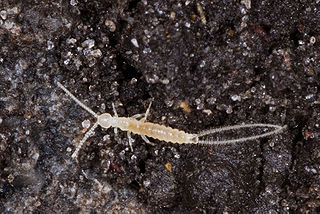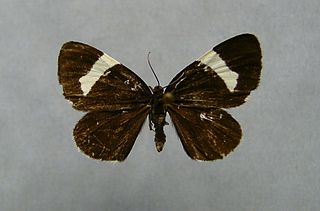
The Lasiocampidae are a family of moths also known as eggars, snout moths, or lappet moths. Over 2,000 species occur worldwide, and probably not all have been named or studied.

Campodea is a genus of small, white, bristle-tailed arthropods in the order Diplura. The best known species, Campodea staphylinus, has a wide distribution across much of Europe. It lives in damp places under stones, fallen trees, or in rotten wood and leaves. There are at least 130 described species in Campodea.

The family Scraptiidae is a small group of beetles sometimes called false flower beetles. There are about 400 species in 30 genera with a world-wide distribution. The adults are found on flowers, sometimes in large numbers. These beetles are very common and easily confused with members of the related family Mordellidae.

Incurvariidae is a family of small primitive monotrysian moths in the order Lepidoptera. There are twelve genera recognised. Many species are leaf miners and much is known of their host plants, excluding Paraclemensia acerifoliella. The most familiar species in Europe are perhaps Incurvaria masculella and Phylloporia bistrigella. The narrow wings are held tightly along the body at rest and some species have very long antennae.

Schinia, commonly called flower moths, is a large genus of moths belonging to the family Noctuidae. The genus has a Holarctic distribution with the vast majority of species being found in North America, many with a very restricted range and larval food plant.

Yponomeutinae is a subfamily of "micromoths" in the lepidopteran family Yponomeutidae. As their scientific name implies, this is the subfamily containing the type genus of the ermine moths, Yponomeuta. The subfamily has worldwide distribution.
Fauna Europaea is a database of the scientific names and distribution of all living multicellular European land and fresh-water animals. It serves as a standard taxonomic source for animal taxonomy within the Pan-European Species directories Infrastructure (PESI). As of June 2020, Fauna Europaea reported that their database contained 235,708 taxon names and 173,654 species names.

Baptria is a monotypic moth genus in the family Geometridae erected by Jacob Hübner in 1825. Its only species, Baptria tibiale, was first described by Eugenius Johann Christoph Esper in 1791. It is found in central and northern Europe.

Nebria is a genus of ground beetles native to the Palearctic, the Near East and North Africa.

Nemapogon variatella is a moth of the family Tineidae. It is found in almost all of Europe. It is also found in North America.

Caecilius fuscopterus is a species of Psocoptera from the family Caeciliusidae that can be found in Great Britain and Ireland. It also common in countries like Austria, Belgium, Croatia, Denmark, Finland, France, Germany, Hungary, Italy, Latvia, Luxembourg. The species are blackish-orange coloured and are similar to Elipsocus abdominalis
Elipsocus abdominalis is a species of Psocoptera from Elipsocidae family that can be found in Great Britain and Ireland. They are also common in countries like Austria, Benelux, Cyprus, France, Germany, Greece, Hungary, Italy, Poland, Romania, Spain, Switzerland, and Scandinavia. The species are blackish-orange coloured and are similar to Caecilius fuscopterus.
Elipsocus hyalinus is a species of Psocoptera from Elipsocidae family that can be found in Great Britain and Ireland. They are also common in countries like Austria, Belgium, Cyprus, Denmark, Finland, France, Germany, Greece, Hungary, Italy, Poland, Portugal, Romania, Spain, Sweden, Switzerland, and the Netherlands. The species are yellowish-black coloured.
Elipsocus pumilis is a species of Psocoptera from Elipsocidae family that can be found in Great Britain and Ireland. They also live in countries like Austria, Benelux, Bulgaria, France, Germany, Greece, Hungary, Italy, Latvia, Poland, Romania, Spain, Switzerland, and Scandinavia. The species are black coloured.
Elipsocus pusillus is a species of Psocoptera from Elipsocidae family that is endemic to Cyprus.
Elipsocus annulatus is a species of Psocoptera from Elipsocidae family that can be found in Austria, France, Germany, Italy, Spain, and Switzerland.
Elipsocus pusillus is a species of Psocoptera from Elipsocidae family that is endemic to Azores.
Elipsocus fasciatus is a species of psocopteran from Elipsocidae family. It is endemic to the Canary Islands.
Britain I. is a distribution area defined in the Fauna Europaea database. It comprises the island of Great Britain and all surrounding islands and island groups including Orkney, Shetland, the Outer and Inner Hebrides, Anglesey and the Isles of Scilly. The Isle of Man is also included in the distribution area.
Elipsocus is a genus of damp barklice in the family Elipsocidae. There are more than 20 described species in Elipsocus.









